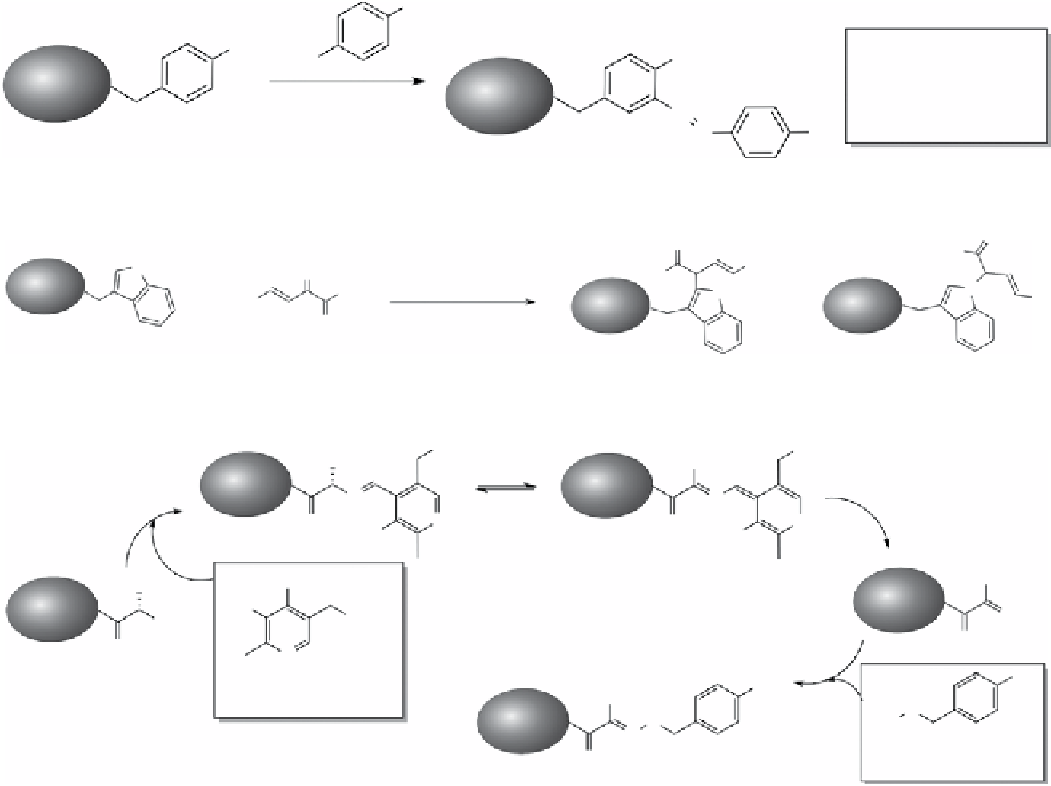Chemistry Reference
In-Depth Information
X
OH
a: X=COCH
3
,>90%
b: X=Br, > 90%
c: X=NO
2
, >90%
d: X=CONH
2
, ~30%
OH
+
N
2
a - d (35 eq)
pH 9, 4°C, 2h
Target protein
Target protein
N
N
X
scheme 2.20
Modification of tyrosine residues on proteins via diazonium-phenol coupling.
O
O
RO
Ph
NH
100 uM Rh
2
(OAc)
4
75 mM H
2
NOH
N
2
RO
N
OR
NH
+
Ph
+
Target protein
Ph
20% Et. Gly. (v/v)
7h (pH~3.5)
Target protein
Target protein
O
(100 μM)
R=(CH
2
CH
2
O)
3
OCH
3
scheme 2.21
Modification of tryptophan residues on protein using rhodium carbenoids.
OPO
2-
OPO
2-
R
R
N
N
HO
Target protein
Target protein
N
O
NH
O
HO
R
CHO
R
HO
O
OPO
2-
Target protein
NH
2
Target protein
O
O
N
10 mM,
pH 6.5, 37°C, 24h
Br
Br
R
O
N
O
H
2
N
8.3 mM,
pH 6.5, r.t., 24 h
Target protein
O
scheme 2.22
Site-selective modification of a protein at its n-terminus where the terminal residue is glycine (R = H), aspartic acid
(R = CH
2
CooH), valine (R = CH(CH
3
)
2
), or methionine (R = CH
2
CH
2
SCH
3
).
2.3.3
n-terminus of protein
Mild transamination reactions were discovered for site-specific modification of n-termini of proteins (Scheme 2.22). The pro-
tein is first treated with an aldehyde overnight at slightly elevated temperature to generate a reactive ketone or aldehyde group
at its n-terminus, which can then be further modified via hydrazone or oxime ligation [254]. The following n-terminal resi-
dues are preferred: aspartic acid, glycine, valine, and methionine. on the other hand, serine, threonine, cysteine, tryptophan,
and proline are found incompatible with the use of aldehydes in the reaction.
2.3.4
c-terminus of protein
one extension of nCL is expressed protein ligation (ePL), which utilised a protein-splicing mechanism by using intein
instead of thioester in one of the peptide components [255, 256]. The target protein can be expressed as a fusion protein with
intein, a protein subunit that is cleaved off via self-catalysed rearrangement by forming a thioester during protein splicing
(Scheme 2.23). The target protein fusion can then be modified in a similar way as that in nCL. Although ePL is more effi-
cient in the synthesis or ligation of proteins of a large molecular weight (greater than 15 Kda), a thiol additive such as thio-
phenol is necessary to facilitate the ligation.
For example, a murine leptin was fused to gyrA intein, which underwent thiolysis first to give an α-thioester before intro-
duction of other functionalities such as imaging probes or other reactive groups [257]. Intein-based expressed protein ligation
has its advantage in terms of site specificity, but its efficiency may not be comparable to that of aniline-accelerated oxime/
hydrazone ligations. Therefore, to achieve highly efficient site-specific labelling of proteins, combined labelling techniques
may be necessary. using a modified intein-mediated ligation approach, Rao and co-workers constructed a Qd-based

